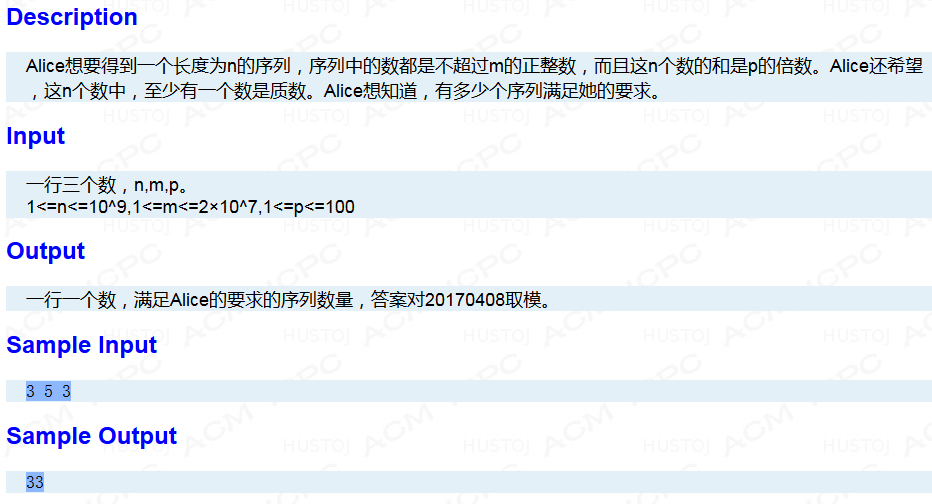转来的题面:
首先这题显然补集转化,就是用全部方案减去不含任何质数的方案。
然后怎么做呢?
考虑m比较小,我们能大力把<=m的质数全都筛出来。
发现n很大,要么倍增要么快速幂......
发现p相当小,所以我们能在mod p的同余系下做啊。
一看到同余系下求方案数立刻想到卷积和生成函数......
假设我们有一个多项式f(x),其中x^i的系数为a个数的序列mod p为i的方案数(a为我们引入的变量)。
同时我们有另一个多项式g(x),其中x^i的系数为b个数的序列mod p为i的方案数(b为我们引入的变量)。
那么,我们如果让f(x)和g(x)做卷积的话,新的多项式x^i的系数就是(a+b)个数的序列mod p为i的方案数的说。
这就是生成函数了。
回到这个题,我们先初始化多项式f(x),令x^i的系数为为1个数mod p为i的方案数。
然后我们求出这个多项式的n次方,就是我们需要的答案了。
发现这道题的p很小,我们连FFT都不用,直接用一个多项式类暴力快速幂就行了。复杂度O(m+p^2logn),跑的飞起。
话说为什么p才100啊,如果修改一下模数然后NTT的话,可以做到p为1e5级别,n为1e18级别的。
代码:

1 #include<iostream> 2 #include<cstdio> 3 #include<cstring> 4 #include<algorithm> 5 #define debug cout 6 typedef long long int lli; 7 using namespace std; 8 const int maxn=1e2+1e1,maxl=2e7+1e2,lim=2e7; 9 const int mod=20170408; 10 11 bool vis[maxl]; 12 int p,m; 13 14 struct Poly { 15 lli dat[maxn]; 16 Poly() { 17 memset(dat,0,sizeof(dat)); 18 } 19 lli& operator [] (const int &x) { 20 return dat[x]; 21 } 22 const lli& operator [] (const int &x) const { 23 return dat[x]; 24 } 25 friend Poly operator * (const Poly &a,const Poly &b) { 26 Poly ret; 27 for(int i=0;i<p;i++) for(int j=0;j<p;j++) { 28 ( ret[(i+j)%p] += a[i] * b[j] % mod ) %= mod; 29 } 30 return ret; 31 } 32 }full,oly; 33 34 inline void sieve() { 35 static int prime[maxl],cnt; 36 vis[1] = 1; 37 for(int i=2;i<=m;i++) { 38 if( !vis[i] ) prime[++cnt] = i; 39 for(int j=1;j<=cnt&&(lli)i*prime[j]<=m;j++) { 40 vis[i*prime[j]] = 1; 41 if( ! ( i % prime[j] ) ) break; 42 } 43 } 44 } 45 46 inline void init() { 47 for(int i=1;i<=m;i++) { 48 full[i%p]++; 49 if( vis[i] ) oly[i%p]++; 50 } 51 } 52 53 inline Poly fastpow(Poly base,int tim) { 54 Poly ret = base; --tim; 55 while( tim ) { 56 if( tim & 1 ) ret = ret * base; 57 if( tim >>= 1 ) base = base * base; 58 } 59 return ret; 60 } 61 62 int main() { 63 static int n; 64 static lli ans; 65 scanf("%d%d%d",&n,&m,&p) , sieve(); 66 init(); 67 full = fastpow(full,n) , oly = fastpow(oly,n); 68 ans = ( full[0] - oly[0] + mod ) % mod; 69 printf("%lld ",ans); 70 return 0; 71 }
